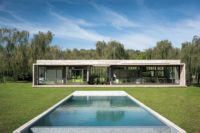When he heard that a family friend had bought a plot of land for her new residence in North Dallas, Paul Merrill, a project architect for 5G Studio, saw it as a unique opportunity. The firm would design its first single-family house and, thanks to the trust already established between client and architect, develop a useful prototype for sustainable living in the hot Texas suburb.
Merrill knew the client wanted to leave a light ecological footprint, but earning LEED certification was not in the original plan. (Nevertheless, the house, completed in 2016, has earned a LEED Platinum rating and is net positive energy, meaning it produces more energy than it uses.)
“When the project started, there was no expectation for this level of energy efficiency,” says principal architect Yen Ong. “It sort of evolved as we educated our client on the benefits and showed her the added value.”
Although the owner lives alone, she wanted the property—known as the Winnwood residence—to have enough space to accommodate frequent visits from relatives. So the architects devised an extensive program comprising three bedrooms, four and a half bathrooms, and a study that converts to a guestroom. A special prep kitchen, a pantry, and a storage room radiate off the open combined living, kitchen, and dining area.
For general energy savings, architects looked first to the building envelope and its site orientation. One challenge: finding ways to let in enough daylight to reduce the need for artificial lighting without causing solar heat gain. Bedrooms featuring full-height glazing with views of the backyard were placed along the building’s north wall. To add shaded outdoor areas but avoid direct sunlight at the east- and western ends, the architects designed inset patios that bookend the main living space (Both are separated from the interior by floor-to-ceiling sliding glass doors with low solar heat gain coefficients). The other perk of the patios is that they allow for enhanced natural ventilation when the home is not being mechanically cooled. When there’s not enough daylight, energy-efficient lighting fixtures are used.
Indoors, architects made sure that sections of the 4,700 square-foot ranch would have the capability to “turn off” when not in use. Thus, each room is individually insulated and has its own thermostat.
Taking cues from a conservation park located across the street, the design team sculpted an intricately landscaped area composed of native and adapted vegetation around the front of the house, to the south. In conjunction with a rainwater harvesting system, the lush plantings use 72 percent less water than comparable landscapes in the area. Branches of a mature oak cantilever over the front door, shading the entry and serving as a welcoming visual landmark. The site’s permeable paving and other stormwater management tools allow most of the rainfall to infiltrate the soil at a level where it is naturally filtered rather than being allowed to run off and flood storm drains. Such strategies, along with lowflow indoor fixtures, can usually help reduce the amount of water a single-family home consumes.
The house, which features an engineered wood frame, also benefits from a geothermal heat pump and a 10-kilowatt solar photovoltaic system. These are expensive up-front investments, but they yield significant long-term energy savings, says Merrill. “When you are looking at additional costs, you have to consider the additional value, too,” he continues. “You aren’t spending money and never getting it back.”
Architects found ways to shave off some of the building costs as well. For the interior walls, for example, the team reduced the level finish of white Venetian plaster from five to three by doing mockups to see how it would reflect or hide variations in the wall. “It’s really important to investigate alternatives and make informed decisions that can reduce premiums,” Merrill explains. Also, a number of building materials used for the new home were repurposed from the house previously occupying the site.
Granted, the initial costs of building a sustainable home present hurdles for homeowners, but the Winnwood property offers an inventive model with features worth emulating. “A home cannot be viewed as an independent element but rather [should be seen] as a series of int erconnected systems, where improvements are achieved not through one decision but through many,” says Merrill. “The prototype is the thoughtful approach.”









Post a comment to this article
Report Abusive Comment